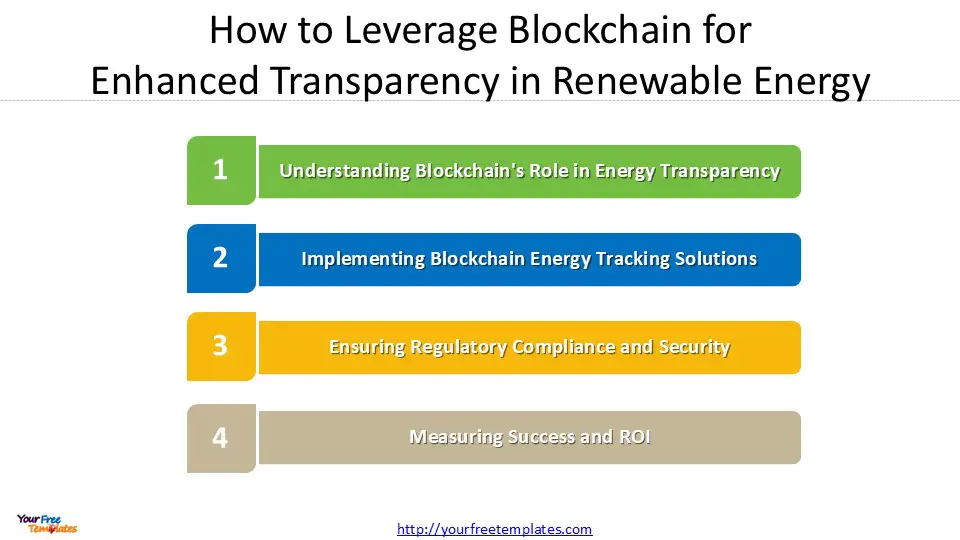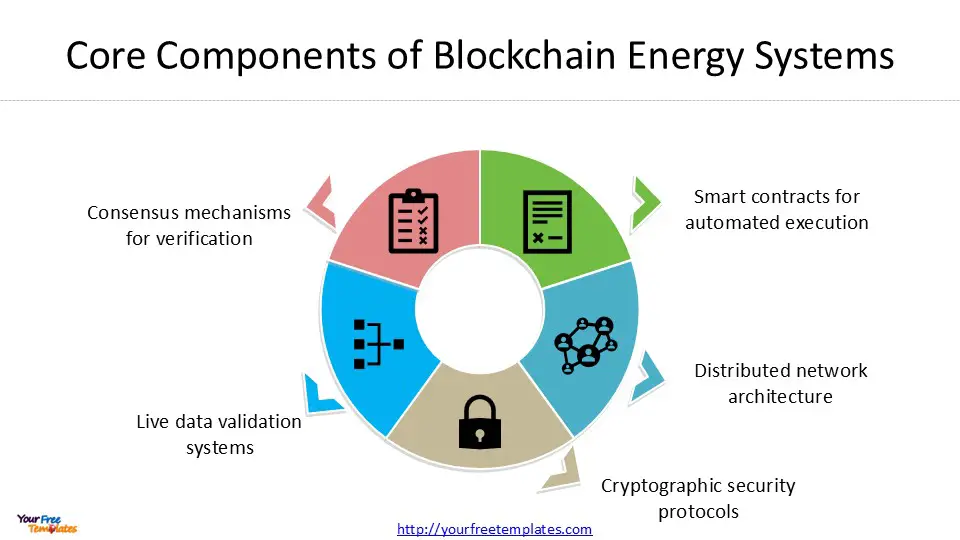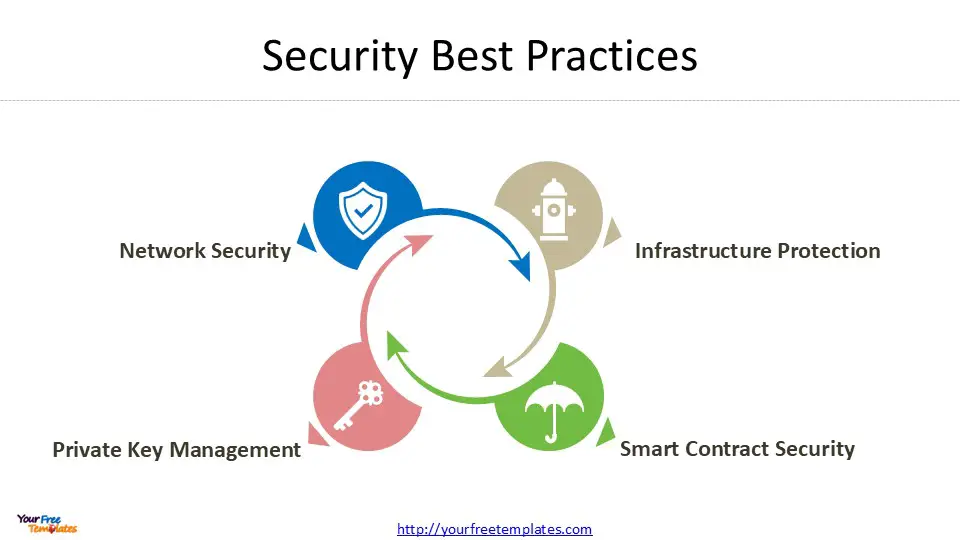Clean energy tracking from source to consumption poses a major challenge for the renewable energy sector. Current systems depend on manual processes and scattered databases. This creates inefficiencies, errors and potential fraud risks. Blockchain in renewable energy provide a reliable answer to transparency issues by creating permanent records of energy generation, distribution and consumption.
At the end of this post, you can download our Blockchain in Renewable Energy PowerPoint template to fit your purpose. As the same diagram PowerPoint template series, you can also find our SPACE Matrix, Bowman’s Strategy Clock, Value Chain Analysis, Climate Change, Carbon Neutral Meaning, Renewable Energy Sources, Generative AI, Circular Economy, Blue Sea Strategy, 2025 Calendar with Holidays, The 7 Habits of Highly Effective People, Six Thinking Hats, Pareto Chart, Occam’s Razor, Data Mining, marketing segment, Porter’s five forces, SWOT Analysis, GE Matrix, BCG Matrix, Artificial Intelligence, National Diamond and BlockChain PowerPoint templates.
Blockchain technology revolutionizes the energy sector through decentralized tracking systems. This piece has everything about blockchain implementation in energy – from technical infrastructure needs to regulatory compliance. You’ll learn about blockchain and renewable energy certificates, data standardization protocols, and ways to integrate with existing systems. The content will help you implement blockchain in renewable energy projects and measure their success through specific metrics.

Understanding Blockchain’s Role in Energy Transparency
Blockchain technology plays a transformative role in the energy sector. Let’s take a closer look at this distributed ledger technology (DLT) that offers a secure, transparent, and immutable platform. This technology reshapes the scene of renewable energy tracking and management 1.
Core Components of Blockchain Energy Systems
A network of independent computers (nodes) forms the foundation of blockchain energy systems. These nodes manage and verify transactions through consensus protocols 1. The core components include:
- Smart contracts for automated execution
- Distributed network architecture
- Cryptographic security protocols
- Live data validation systems
- Consensus mechanisms for verification
Benefits of Distributed Ledger Technology
DLT brings several advantages to the renewable energy sector:
- Boosted Security: Decentralized systems resist cyber attacks and system failures better 2
- Transparent Operations: Authorized personnel can access power grid data through recorded transactions 3
- Automated Processes: Smart contracts make operations efficient and reduce intermediary requirements 4
- Cost Reduction: The technology coordinates data among multiple parties and substantially lowers operational costs 5
Key Stakeholders in the Energy Value Chain
The blockchain-enabled energy ecosystem naturally connects multiple stakeholders. The system enables consumers, producers, and grid operators to participate actively in energy transactions and decision-making 3. Peer-to-peer (P2P) energy trading allows direct sale of surplus renewable energy to local consumers, which creates mutual benefits 3.
IoT sensors blend with blockchain to deliver reliable measurement and verification solutions 3. This combination coordinates the power grid in real time and improves energy flows between generators and users 3.

Implementing Blockchain Energy Tracking Solutions
Blockchain solutions have practical applications in renewable energy tracking. Research demonstrates that blockchain’s decentralized structure provides unchangeable records, transparency, and automation which address current energy tracking challenges 6.
Technical Infrastructure Requirements
The right blockchain platform and consensus mechanism selection is vital to success. Studies reveal that 42% of projects suggesting new consensus methods and 46% developing new platforms face implementation difficulties 6. This data suggests teams should make use of standard blockchain platforms and consensus mechanisms to boost practicality and create adaptable solutions.
Essential technical components include:
- Distributed security protocols
- Smart contract capabilities
- Consensus mechanisms
- Data validation systems
- Integration interfaces
Data Standardization Protocols
Data standardization remains a significant challenge even with multiple stakeholders working in parallel 6. Teams should establish uniform protocols for:
- Energy flow recording
- Transaction validation
- Smart contract execution
- Cross-chain communication
- Data format standardization
Integration with Existing Energy Systems
Blockchain in Renewable Energy technology enables decentralized energy supply systems where power producers, distribution operators, and consumers connect directly through the blockchain network 7. Teams must think over existing infrastructure during integration.
Smart contracts can control energy networks effectively. They manage energy and storage flows automatically based on pre-defined rules 7. This automation helps balance supply and demand by a lot. Blockchain-IoT integration presents challenges, but solutions like Chainlink provide temporary bridges to close this gap 6.
The market shows great promise. Projections indicate growth from USD 3.00 billion in 2020 to USD 39.00 billion by 2025 8. This growth shows how organizations increasingly recognize blockchain’s ability to improve data verification and provide uninterrupted, immediate monitoring of energy systems.

Ensuring Regulatory Compliance and Security
Blockchain implementation for renewable energy tracking needs to address security and regulatory compliance as critical priorities. Research shows that regulatory agencies now look more closely at blockchain implementations. Multiple federal and state-level bodies claim jurisdiction over digital asset systems 9.
Meeting Energy Market Regulations
Energy market regulations change faster to make room for blockchain technology. The European Green Deal highlights that energy markets should be fully integrated, interconnected, and digitalized 10. System operators need to promote digitalization through smart grids and live data acquisition. They must also support cybersecurity and data protection measures 10.
Data Privacy Considerations
Privacy concerns stand at the forefront of blockchain energy systems. Studies show that traditional schemes expose sensitive details like load patterns, user behaviors, and local generation device information 11. The solution to these challenges lies in:
- Encrypted subproblem processing before blockchain transmission
- Hardware-backed edge devices with Trusted Execution Environment
- Privacy-preserving protocols for sensitive data handling
Security Best Practices
Blockchain security incidents hit record levels in 2022. This is a big deal as it means that losses went beyond $4.00 billion 12. Here are the essential security measures we’ve identified:
- Infrastructure Protection: Zero-trust architecture, VPNs, and strong firewalls implementation
- Smart Contract Security: Regular auditing and testing of smart contracts before deployment
- Private Key Management: Strong access controls and hardware wallet storage
- Network Security: Detailed protection in participating organizations
Successful blockchain implementation needs a balance between security measures and operational efficiency. Our method combines both on-chain and off-chain security architectures. This helps meet complex requirements in multi-blockchain business environments 13.

Measuring Success and ROI
The measurement and review of blockchain in renewable energy projects’ return on investment (ROI) needs a systematic approach. Companies that use blockchain solutions have seen a 41% positive ROI 14. This shows how the technology creates real value.
Key Performance Indicators
The success of blockchain energy implementations can be measured through these vital KPIs:
- Transaction Metrics: Speed and throughput show 30-40% improvement over traditional systems 15
- Operational Efficiency: Processing times dropped from days to minutes 15
- Data Quality: Better accuracy and reliability in energy tracking
- Security Performance: Lower instances of data tampering and fraud
- User Adoption: Growing network participation and involvement
Cost-Benefit Analysis Framework
A detailed cost-benefit analysis should look at both tangible and intangible assets 14. Multi-criteria Decision Analysis (MCDA) offers the best way to review blockchain implementations. The core aspects include:
- Original development and deployment costs
- Ongoing operational expenses
- Training and maintenance requirements
- Efficiency gains and cost savings
- Better data security and reliability
Blockchain reduces operational costs through:
- No need for intermediaries
- Efficient processes
- Automated task execution
- Better resource allocation 15
Impact Assessment Methods
Life Cycle Assessment (LCA) serves as our main impact measurement tool. Many organizations use it to review environmental impacts across product systems 16. LCA helps us:
- Find ways to lower environmental impacts
- Create more sustainable products
- Support realistic marketing claims
- Back environmental policies and programs 16
The biggest challenge remains collecting reliable data quickly across the supply chain 16. We solved this by combining blockchain technology with other smart enabling technologies. This combination helps achieve operational excellence at every assessment stage 16.

Conclusion
Blockchain technology is a powerful solution that tackles renewable energy tracking challenges and provides clear transparency and better efficiency. Our complete analysis showed how distributed ledger systems build secure, automated platforms that help all stakeholders in the energy value chain.
The blockchain implementation can achieve several important results:
- Lower operational costs through automated smart contracts
- Better data security with cryptographic protocols
- Simplified processes for regulatory compliance
- Clear ROI with performance indicators
- Live tracking and verification capabilities
The success metrics show blockchain works well with 41% positive ROI and 30-40% faster transaction processing. These results plus standardized protocols and proper security measures are the foundations of strong renewable energy tracking systems.
Blockchain technology keeps maturing and promises bigger advances in energy sector transparency and efficiency. Some challenges exist in data standardization and IoT integration. The framework we outlined gives clear direction to implement this successfully.
Looking for Premium maps, please visit our affiliate site: https://editablemaps.com/ or https://ofomaps.com/
Size:243K
Type: PPTX
Blockchain in Renewable Energy Template
Click the link to download it.
Aspect Ratio: Standard 4:3
Click the blue button to download it.
Download the 4:3 Template
Aspect Ratio: Widescreen 16:9
Click the green button to download it.
Download the 16:9 Template
References
[1] – https://www.belfercenter.org/publication/role-blockchain-green-hydrogen-value-chains
[2] – https://www.investopedia.com/terms/d/distributed-ledger-technology-dlt.asp
[3] – https://www.forbes.com/councils/forbestechcouncil/2023/07/18/the-blockchain-disruption-transforming-the-energy-industry-with-transparency-efficiency-and-decentralization/
[4] – https://appinventiv.com/blog/blockchain-in-energy-sector/
[5] – https://consensys.io/blockchain-use-cases/energy-and-sustainability
[6] – https://www.sciencedirect.com/science/article/pii/S2772671124003310
[7] – https://www.sciencedirect.com/science/article/abs/pii/S1574013720300241
[8] – https://blaize.tech/article-type/overview/blockchain-in-energy-market/
[9] – https://www.thomsonreuters.com/en-us/posts/corporates/compliance-crypto-industry/
[10] – https://publications.jrc.ec.europa.eu/repository/bitstream/JRC125216/JRC125216_01.pdf
[11] – https://www.nature.com/articles/s41467-024-48860-7
[12] – https://www.techtarget.com/searchsecurity/tip/8-best-practices-for-blockchain-security
[13] – https://www.sciencedirect.com/science/article/pii/S2667295224000369
[14] – https://www.zeeve.io/blog/achieving-roi-with-blockchain-in-the-enterprise-a-cost-benefit-analysis/
[15] – https://fastercapital.com/content/Blockchain-success–Measuring-ROI–Key-Metrics-for-Blockchain-Success.html
[16] – https://www.sciencedirect.com/science/article/abs/pii/S0921344919304185














